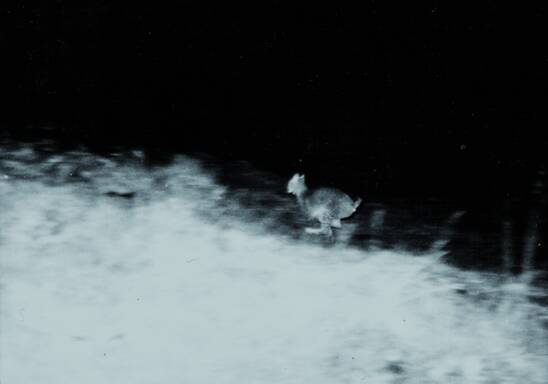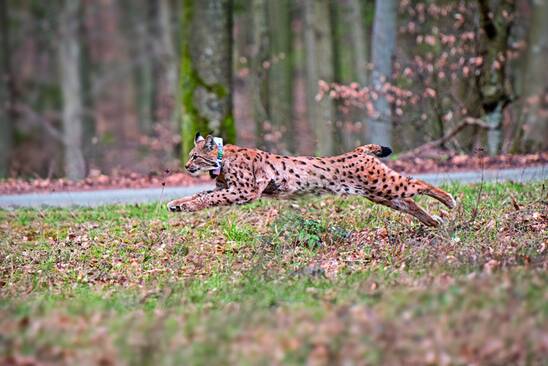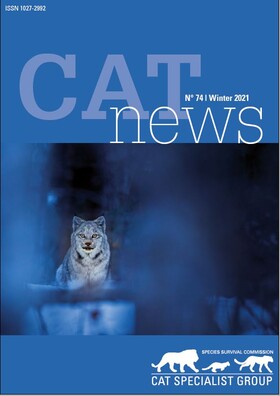Editorial
50 years...
In 2021, Switzerland celebrated the 50-year anniversary of the reintroduction of the lynx. Actually, “Switzerland celebrated” might be a bit exaggerated considering the small group of folks that got together under the restrictions of the pandemic and the modest media echo the event triggered. Nevertheless, the reintroduction of the lynx marked a milestone in the conservation of wildlife in Europe and cat conservation world-wide.
The Foundation KORA, the host of the IUCN SSC Cat Specialist Group, produced a special publication summarising the experience of these 50 years (https://www.kora.ch/fileadmin/KORA_Bericht_99_D_50_Jahre_Luchs_in_der_Schweiz.pdf), which will soon be available not only in German, but also in French and English. Concurrently, we published the proceedings of a conference on the conservation of the Eurasian lynx in continental Europe (Cat News Special Issue No 14: http://catsg.org/index.php?id=716), presenting a number of recommendations on how to secure the long-term survival of this elusive predator in West and Central Europe.
Half a century has passed since the first releases in the Swiss Alps. Subsequently, Eurasian lynx were reintroduced in many more countries across the continent, but up to now, the reintroduced populations remain small and isolated. Although individual lynx can cross any artificial or natural barrier in European landscapes and dispersing males occasionally travel far, the expansion of the populations in this highly fragmented landscape is very slow, due to the philopatric character of the females. Several of the populations founded in the 1970s and 1980s require genetic remedy, and more reintroductions and reinforcement releases are needed to support the expansion of the populations and merge them to one large continental metapopulation.
Nevertheless, 50 years of experience with the reintroduction of the lynx has shown that the Eurasian lynx can be reintegrated into one of the most anthropogenic landscapes on the globe. Continental Europe has no chance to delineate protected areas able to host viable populations of large mammals. The only hope is that large herbivores and large carnivores can be conserved in this human-dominated landscape in coexistence with people.
Urs Breitenmoser

- Release of a Carpathian lynx in the Swiss Alps in 1973…

- … and in the Palatinate Forest, Germany, in 2020 (Photo A. Prüssing, SNU).
A decade of snaring of leopards in a South African province by R. J. Power, M. V. Botha, N. Strydom, S. Mselek, L. Venter and P. Bartels
The use of wire snares in the bushmeat trade is likely to have a serious impact on non-target felid populations worldwide. In South Africa’s North West Province, we reported 22 snared leopards Panthera pardus from 2010 to 2020, of which ~45% had died, while just over half had been rescued and survived. Based on concurrently satellite collared leopards, of all types of mortality, the contribution of snares was ~33%. There is even potential to reverse imminent death via rescue and treatment of collared animals, but this is dependent on high quality satellite telemetry with low positional errors. Solutions to eliminate snaring are as follows: a) conduct regular anti-snaring patrols in ‘hotspot’ areas, b) satellite collaring of leopards to pin-pointing both snaring ‘hotspots’ and rescuing them from snares, and then c) to dissuade a bushmeat industry by encouraging large-scale food subsidies to local communities (i.e. fish in large man-made dams). In the future, extreme interventions aimed at individual felids may become a common place given anticipated human-modification of many landscapes.
Supporting Online Material
Confirmed presence of African golden cat in Mbam et Djerem National Park, Cameroon by A. D. T. Mouafo, V. A. Binda, T. A. Il, F. T. Simo, I. C. N. Ngwayi, E. D. A. Ongono and D. J. Ingram
We provide new camera trap records of African golden cats Caracal aurata from Mbam et Djerem National Park, contributing to a growing understanding of the species’distribution in Cameroon.
First record of the African golden cat in Central Uganda by T. E. R. G. Huijsmans, G. L. M. Huijsmans, I. L. M. Huijsmans and A. T. Namuwonge
During preliminary research for a survey to determine the species that inhabit the Mpanga Central Forest Reserve in Uganda, the African golden cat Caracal aurata has been recorded with a camera trap. This is the first record of the African golden cat in this reserve and the region of Central Uganda. More research on the population size, threats, conservation needs, and distribution is recommended.
First record with physical evidence of African golden cat from Angola by E. de Beer, J. P. Nicolau and L. T. B. Hunter
There are significant gaps in understanding the distribution of the African forest endemic,the African golden cat, Caracal aurata. Although Angola is included as a range country for the species, we know of no material record. Here, we document the first record with physical evidence of the species, from a bushmeat vendor in Uige Pro-vince, northern Angola.
The first photographic record of junge cat from Markazi Province, Central Iran by A. Shahinpour, D. Nayeri and M. Mousavi
During a field survey, we photographed a jungle cat Felis chaus in the vicinity of Kharaqan No-Hunting Area in Markazi Province, Iran on 30 December 2020. To our knowledge, this is the first hard evidence of this species occurrence in the province.
Supporting Online Material
Snow leopards and prey in Rolwaling Valley, Gaurishankar Conservation Area, Nepal by B. P. Pandey, S. Thami, R. Shrestha, N. Subedi, M. K. Chalise and S. B. Ale
The snow leopard Panthera uncia, an apex predator of the Himalayan ecosystem, often shares habitat with the wolf, Canis lupus, red fox Vulpes vulpes, and other carnivores. A biodiversity monitoring programme primarily focused on the assessment of the status of snow leopard and its prey in Rolwaling valley of Gaurishankar Conservation Area, Nepal, was carried out during June–November 2019. We deployed single camera traps in each of twelve grids sized 16 km2 each, operated 24 hours, and left alone for the whole study period. A single snow leopard was captured thrice on same camera in Rhododendron anthopogon-Hippophae thibetana scrubland, near Tsho Rolpaglacial lake (4,536 m). Alongwith snow leopard, wolves were also photographed at three sites namely Yelung pass (4,956 m), Tsho Rolpa (4,536 m) and Dudhkunda ridgeline(5,091 m). The red fox was the most frequent predator in Rolwaling while stone marten Martes foina, yellow-throated marten Martes flabigula, and yellow-belied weasel Mustella katiyah were captured occasionally. Photo capture rate index PCRI per 100 trap nights was calculated for all identifiable species where snow leopard and wolf had PCRI values of 0.35 and 0.71, respectively. The Cumulative PCRI values suggest a pyramid shaped community structure in Rolwaling with small herbivores (including game birds) with broad base (PCRI 22.29) followed by large herbivores (10.38) and small-medium sized carnivores (6.96). The top predators (snow leopard and wolf) produces 1.06 photographic rate index. The declaration of Gaurishankar conservationarea and continuous efforts from conservation area management committees, strict cultural rules from local Buddhist community in the valley are found possibly favoured the recolonization of the wolf and frequent visits by snow leopard.
Supporting Online Material
An experience of surplus killing of livestock by a snow leopard in Nepal by K. Thapa
Among many other threats, retaliatory killing of snow leopards Panthera uncia by people in retribution of livestock depredation is the foremost challenge for long-term survival of snow leopards. Surplus killing of up to 100 or more goats and sheep by snow leopard in a single night have been reported in snow leopard range’ countries including Nepal. Such incidences are unusual, but their impacts are substantial for subsistence agropastoral communities and snow leopard survival. Direct observation of surplus killing of livestock by a snow leopard in the corral is very rare. Here I report one incidence in a remote part of Nepal where a snow leopard killed 44 goats and was then trapped itself in a corral. This note highlights how I managed to rescue the trapped snow leopard.
Evidence of rusty-spotted cat in Shivalik Forest Division, Uttar Pradesh, India by D. Pawar, S. Umariya, S. Shafi, V. Jain, A. Singh and T. P. Bopanina
The rusty-spotted cat, Prionailurus rubiginosus is considered to be the world’s smallest species of wild cat. We report here the first photographic evidence of the rusty-spotted cat from the Shivalik Bhabar region of Shivalik Forest Division in Uttar Pradesh, India. This evidence adds another record to the rusty-spotted cat distribution in the Western Terai Arc Landscape.
Increasing evidence of tiger in North Sikkim, India by S. Umariya, C. Sylvia, P. Chanchani, P. Lachenpa, D. Lachungpa, P. Shrestha, D. Ghose, R. Gopal, M. Kapoor and R. Solanki
We report here photographic evidence of two tigers Panthera tigris tigris from the North Sikkim Territorial Forest Division, North Sikkim district, in Sikkim, India. These tigers were photo-captured at elevations of 2,425 m and 3,602 m in the months of June-July 2019 from an area where very little is known about the species occurrence. These records and additional evidence suggests that a tiger population may occur at low densities in remote Himalayan forests of North Sikkim.
Supporting Online Material
High elevation record of clouded leopard in community forests of Nagaland, India by R. Nair, A. Yimkhiung, H. Yimkhiung, K. Yimkhiung, Y. Yimkhiung, T. Wungtung, A. Basker and S. Nijhawan
Clouded leopards Neofelis nebulosa are largely thought to inhabit low elevation primary evergreen rainforests across their known range. Here, we present a camera trap record of a clouded leopard captured at an elevation of 3,700 m in community-owned forests along the Indo-Myanmar border in Nagaland, India. We believe this is one of the highest records ever of a clouded leopard in India. Local communities in Nagaland own and manage a large majority of the region’s forests, with a range of village-specific management regimes. Our surveys found these community forests to host a high diversity and abundance of several globally threatened taxa. We recommend more surveys, conducted ethically, equitably and collaboratively with local people, within non-state protected forests which may hold potential for scientifically unregistered populations of clouded leopards and other threatened wild felids.
Melanism in the Brazilian pampas cat and range extension in the Atlantic Forest, Brazil by I. Aximoff, D. Sales, E. Painkow, G. Barquero, C. Rosa and A. Caravaggi
The biogeographical and natural history of the Leopardus colocola braccatus (Carnivora,Felidae), known as Brazilian pampas cat, including its coat colouration are poorly understood. Here we report new records of melanism in the Brazilian pampas cat, obtained from three localities in central Brazil. We also provide the southern most known record, extending its known distribution range by approximately 300 km into the Atlantic Forest domain. During the fieldwork for a mammal survey (2010–2020) we searched for records of melanistic individuals at ten sites spread across three Brazilian domains: Atlantic Forest, Cerrado, and Pantanal. We collected 50 Brazilian pampas cat observations. We obtained in total eight records of melanistic individuals in three protected areas: one site was located in the Atlantic Forest and two sites in the Cerrado (all located in Mato Grosso do Sul state). Despite the long-term camera-trap survey (29,000 nights of camera traps), only 16% of the records were of Brazilian pampas cat showing polymorphic phenotypes. Our findings provide important contributions to our understanding of the species and have potential ecological and evolutionary significance. We strongly encourage further research on this species.
Supporting Online Material
First record of jaguar in the Triângulo Mineiro and Alto Paranaíba mesoregion, Brazil by M. E. de Avelar Fernandes and C. R. da Silva
We documented the first record of a jaguar Panthera onca from the Triângulo Mineiro and Alto Paranaíba mesoregion, in Minas Gerais state, Brazil. In February 2021, we recorded an adult jaguar by camera trap in a property named São Sebastião Monte Alto, located in the municipality of Araxá. This record represents the first evidence of jaguar presence in this Cerrado region.
Wildlife photographers can help conservation by S. Kennerknecht
Wildlife photography is the most popular genre of photography in the world. There are hundreds of thousands of women and men who enjoy taking photographs of animals in the wild. For most it is a fun hobby. For a select few it is a profession. No matter whether they are making money off the images they take, they all have the ability to be citizen scientists by capturing the world they see. There are four main ways that wildlife photographers can help wild cat biologists with their images.
Mainland clouded leopard: IUCN Red List status update by T. N. E. Gray, J. Borah, C. N. Z. Coudrat, Y. Ghimirey, A. J. Giordano, E. Greenspan, S. Mohamad, W. J. Petersen, S. Rostro-García and W.-M. Wong
In September 2021, the Cat Specialist Group completed the Red List Assessment for mainland clouded leopard Neofelis nebulosa (Gray et al. 2021) for the IUCN Red List of Threatened SpeciesTM. Since the previous Red List assessment (Grassman et al. 2016), there have been several published studies investigating the range-wide distribution of remaining habitat and recent occurrence records (e.g., Macdonald et al. 2019, Petersen et al. 2020a). These assisted the most recent assessment, as did new published estimates on site-specific population densities (e.g., Singh & Macdonald 2017, Petersen et al. 2020b, Fig. 1.). This latest assessment resulted in the species maintaining its status as globally Vulnerable.
Better knowledge for better management: Javan leopard is downlisted to Endangered by E. Wilianto, D. A. Rahman, D. S. Chandradewi, I. M. R. Pinondang and H. T. Wibisiono
The latest assessment of the Javan leopard Panthera pardus melas for the IUCN Red List of Threatened SpeciesTM resulted on revised categorization of the species from Critically Endangered (CR) to Endangered (EN). This downlisting was defined based on better information and data quality about the geographical distribution, populationsize, and threats. However, this re-categorization of the status does not necessarily imply an improvement in population conditions and decreased threats, nor is it evidence of the conservation intervention success. This can also be seen from the fact, that the Javan leopard is very close to classify for Critically Endangered under criterion C2a(i) (small population size and decline, and small subpopulation size). We believe that the condition of the leopard in the wild is not yet viable and the level of threat is still at a concerning level. Therefore, it must be monitored and reassessed periodically, using new information as a basis for planning and implementing the necessary interventions.
Integrated actions for the conservation of the Central American oncilla by J. D. Ramírez-Fernández, P. B. Murillo, F. Araya-Chavarría, J. C. Delgado-Carazo, V. Gallardo and S. Pastor-Parajeles
Small wild cats have gone unnoticed by the conservation world for many years. Under the umbrella species concept, most cat conservation programmes around the world have focused on the seven largest generalist species, leaving more than 30 species of small specialists to fend for themselves. The Central American oncilla Leopardus tigrinus oncilla, the smallest cat in the region, faces many threats and is classified as endangered by local authorities. The Oncilla Conservation program within the Costa Rica Wildlife Foundation has stepped forward on behalf of it survival and well being for the years to come. By working with local communities, through an interdisciplinary approach, we are taking small wild cat conservation to the next level.
Supporting Online Material
Experts' opinion on status and threats of marbled cat by G. R. Regmi and P. B. Ale
Google Forms was used to assess the status of and threats to the very elusive and rare marbled cat Pardofelis marmorata in its range countries including Nepal. The survey link was sent by emails on 07 August 2020 to 200 experts globally. Response were received beteween 07 August 2020 and 16 September 2020. Out of 200, 120 responded to our survey. 108 participants had knowledge on small wild cats and 92 of them responded to marbled cat related questions. All respondents agreed that marbled cat has been facing serious survival threats in all of its range countries. The participants chose the habitat loss as the primary threat for the marbled cat followed by hunting, poaching and illegal trade. They have equally suggested habitat protection, effective implementation of laws by authorities and community outreach programmes as the threat mitigation measures for the marbled cat. The conservation partners and related stakeholders are required to commence such conservation actions to save one of the world’s most secret small wild cats from extinction.
Supporting Online Material
Engaging fishing dependent communitites in fishing cat conservation by G. Puri, S. Poudel and I. Tharu
Conservation is not only finding the micro- and macro-biological facts of the species, but it is also about understanding the interactions and issues between the society, species and its habitat and solving such issues and problems collaborating with local communities to ensure the protection of the species and its habitat. Considering these facts, the empowerment, involvement and stewardship of fishing cat conservation was initiated in the Western Terai Arc Landscape of Nepal. Using multiple approaches,such as, community consultation and workshops, participatory mapping, community radio programmes and formation of school eco-clubs, the project increased the awareness about the importance of fishing cat Prionailurus viverrinus and its habitat and local interests in the conservation of the species by empowering and involving the fishing dependent communities that live aside by the fishing cat habitats.
Supporting Online Material


